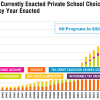Immediately after the Supreme Court overturned his last big student loan forgiveness plan, President Biden announced a new effort that would rely on a different law, an effort that is now nearing completion. The administration has released the draft regulations that would waive accrued interest, forgive debt for borrowers that have repaid for 20 years (25 years if there is debt for graduate school), automatically enroll students in programs that would result in loan forgiveness, and waive debt for students that attended low‐quality institutions. The administration hopes to issue final regulations in a few months with a goal of forgiving debt this fall.
The administration estimates that 27.6 million borrowers (around 64 percent of all borrowers) would have some or all of their debt forgiven under the proposed regulations. Around 9 percent of all outstanding student loan debt would be forgiven, at a cost of $147.5 billion.
This plan suffers from several severe flaws.
- The proposed regulations are unfair.
One of the big selling points for going to college is that college graduates earn more, which means that forgiving student loans tends to be regressive. The main exception to this would be dropouts who take on debt but do not get the expected earnings boost. The new regulations do not specifically target such students. In fact, the Penn Wharton Budget Model estimates that the typical household income of beneficiaries for the most regressive provision is $313,000. This clearly is not a well‐targeted plan to help those in need. Indeed, the administration admits that “President Biden has vowed to use every tool available to cancel student debt for as many borrowers as possible, as quickly as possible.”
Even if forgiving loans was not regressive, it would still be unfair. Why should those who never went to college (some of whom avoided it because they didn’t want to take on debt), or those who paid off their loans, or parents who worked extra hours to help their children avoid debt now have to pay for other people’s student loans?
- The proposed regulations are bad policy.
Two common mistakes of student loan programs are using them to subsidize education and using an inappropriate interest rate. The proposed regulations exacerbate both errors.
Regarding subsidies, whether and how much we subsidize college is a completely separate question from how student loans should operate. As Susan Dynarski and Daniel Kreisman wrote for the Brookings Institution,
The government should seek neither to make nor to lose money from student loans. Student loans correct a capital market failure … Federal student loans therefore solve a liquidity problem, not a pricing problem. Student loans are appropriate neither for raising revenue nor for subsidizing college.
Whether you want to subsidize colleges a lot, a little, or not at all, student loans aren’t the way to do it. As I summarized in a study from 2020,
Student loans are a terrible method of subsidizing higher education. Providing subsidies through loans … is poorly targeted, distributing the subsidy only to those who borrow. Yet around half of all community college graduates do not take out loans. Using loans to subsidize higher education also gives the biggest subsidies to those who borrow the most (relatively wealthy graduate students).
Unfortunately, student loans are heavily subsidized. The Congressional Budget Office estimates that the subsidy rate for the student loan portfolio is 21.6 percent, meaning that the government will lose 21.6 cents for every dollar that is lent. The proposed regulations would increase this subsidy even further.
Regarding interest rates, Nicholas Barr argues that the interest rate on student loans should be close to the interest rate the government pays to borrow. Yet the proposed regulations would waive interest for millions of borrowers including those in income‐driven repayment plans. Yet Barr points out that “In a system with income‐contingent repayments and forgiveness after 25 years, an interest subsidy achieves no single desirable objective.” By retroactively setting the interest rate to zero for many borrowers, the regulations would move us even further from a sound policy.
- Biden does not have statutory authority to impose these regulations.
The administration’s last attempt at loan forgiveness was thrown out by the Supreme Court for violating the major questions doctrine, which requires clear congressional authorization for executive actions of major economic or political issues.
Student loan forgiveness on the scale proposed in these regulations clearly meets the major economic or political threshold. The overturned loan forgiveness plan was estimated to cost around $500 billion. The Committee for a Responsible Federal Budget estimates this one would cost $250–750 billion once you include the economic hardship provisions (which are still under development). Even the $147 billion cost that the administration estimates (which excludes the economic hardship provisions) would qualify as major since it dwarfs the scale of annual aid provided by main federal financial aid programs like Pell Grants ($27 billion) and student loans ($83 billion).
Nor is there clear statutory authorization. As Mark Kantrowitz lays out, the entire legal case for the regulations rests on a provision that allows the Secretary of Education to “enforce, pay, compromise, waive, or release any right, title, claim, lien, or demand, however acquired, including any equity or any right of redemption.” Yet there are four problems with the claim that this provides legal authorization for the new regulations.
First, the most plausible reading of this authority is that it applies to loan forgiveness plans that have been authorized by laws Congress has passed, such as the Public Sector Loan Forgiveness (PSLF) program. Congress passed a law setting up PSLF, with all sorts of eligibility criteria and requirements to waive debt for some borrowers. Why would they have done that if the secretary could have just waived all that debt under existing law?
Second, the waiver authority is granted for a different loan program. In particular, it applies to the Federal Family Education Loan Program (FFELP) which stopped making loans in 2010, not the Direct Loan (DL) program under which all new and most old debt falls. The administration claims that a provision stipulating that DL loans “have the same terms, conditions, and benefits” as FFELP loans means the waiver authority applies to DL too. But as Kantrowitz notes, “a waiver of a ‘right, title, claim, lien, or demand’ is not a term, condition or benefit of a loan.”
Third, the secretary’s waiver authority is only authorized on a case‐by‐case basis. For example, PSLF requires students to document their eligibility and income, which are then evaluated separately for each borrower. The proposed regulations ignore the requirement that waivers be granted on a case‐by‐case basis and instead try to waive part or all of the debt for almost two‐thirds of borrowers en masse.
Fourth, the regulations ignore the requirement that the federal government try to collect the debts it is owed. In particular, the Federal Claims Collection Standards lay out various conditions under which debts to the federal government can be waived. How do the new regulations deal with these requirements? By simply stating they can be ignored. Is everyone now allowed to just ignore regulations they don’t want to comply with, or just the Biden administration?
In sum, the proposed regulations are unfair, badly designed, and lack legal authorization. They would further distort an already badly designed student loan system. Unfortunately, the courts are the only way to stop the regulations from taking effect. Fortunately, the previous failed student loan forgiveness plan has provided a roadmap to defeat this one in court too—namely, Missouri (which has standing to sue due to quasi‐public student loan servicing entity) sues and the courts find the plan violates the major questions doctrine (which requires clear congressional authorization for executive actions of major economic or political issues).





















